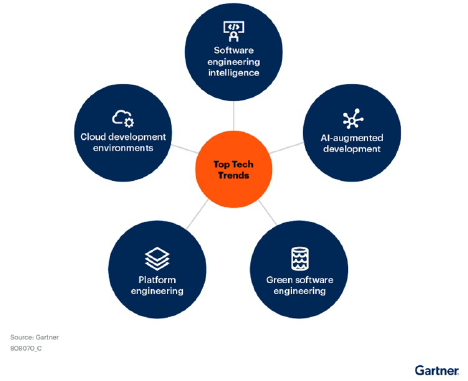Gartner: AI-Augmented Development Hits Radar for 50%-Plus of Enterprises
Gartner says use of GenAI and other AI-augmented development tools alongside traditional tools are a top trend in 2024. Use cases include producing application code, enabling design-to-code transformation and even doing better testing. IDN talks with Gartner VP Joachim Herschmann.
by Vance McCarthy
Tags: AI, apps, coding, development, Gartner, GenAI, SDLC, testing,

VP Analyst

"Investing in AI-augmented development will support software engineering leaders in boosting developer productivity and controlling costs."
 Modern Application Development for Digital Business Success
Modern Application Development for Digital Business SuccessEnterprise adoption of AI-augmented development is taking hold across a wide range of companies and professionals – and this trend will get even stronger through 2024 and beyond, according to recent research released by Gartner Inc.
Software engineering leaders need a cost-effective way to help their teams build software faster, according to Joachim Herschmann, VP Analyst at Gartner.
A recent Gartner survey found more than half (58%) of respondents said their organization is using or planning to use generative AI over the next 12 months to control or reduce costs.
Gartner defines AI-augmented development as “the use of AI technologies, such as generative AI and machine learning, to aid software engineers in designing, coding and testing applications.”
“AI-augmented development tools integrate with a software engineer’s development environment to produce application code, enable design-to-code transformation and enhance application testing capabilities,” Herschmann said. “Investing in AI-augmented development will support software engineering leaders in boosting developer productivity and controlling costs and can also improve their teams’ ability to deliver more value.”
Gartner’s research also found AI-augmented development “increases developer productivity across the SDLC” highlighting several areas, Herschmann told IDN.
- Automatically generating front-end code from designs — Design-to-code tools save time during the Plan phase.
- Generating code — AI code assistants enable faster coding during the Create phase.
- Providing shift-left testing capabilities — AI-augmented testing tools accelerate the Verify phase.”
Beyond these ROI-based benefits, Herschmann said AI-augmented development provides benefits “beyond productivity gains and cost reduction.” In specific:
Developers want to work with AI! Working with cutting-edge technologies is appealing to developers. The 2024 Gartner Software Engineering Survey found that retaining top performers and attracting high-quality applicants are the most difficult activities for software engineering leaders to accomplish. Adopting AI-augmented development tools can enhance the developer experience and help organizations to attract and retain talented people.
Organizations are prioritizing software quality! In that same [Gartner] survey thirty-four percent of software engineering leaders reported that improving software quality was one of their top three performance objectives. AI-augmented development can enable software engineering leaders to drive improvements in code’s quality and maintainability.
AI-Augmented Development Among 5 Trends for 2024
Gartner identified AI-Augmented Development as one of five top strategic technology trends for software engineering for 2024.

Other top trends Gartner calls out include:
- Software engineering intelligence. This provides a unified, transparent view of engineering processes that helps leaders to understand and measure not only velocity and flow but also quality, organizational effectiveness, and business value. Gartner predicts by 2027, 50% of software engineering organizations will use software engineering intelligence platforms to measure and increase developer productivity, compared to 5% in 2024.
- Platform engineering. This reduces cognitive load for developers by offering underlying capabilities via internal developer portals and platforms that multiple product teams can use. These platforms provide a compelling “paved road” to software development, which saves time for developers and improves their job satisfaction. Gartner predicts that by 2026, 80% of large software engineering organizations will establish platform engineering teams, up from 45% in 2022.
- Cloud development environments. These provide remote, ready-to-use access to a cloud-hosted development environment with minimal effort for setup and configuration. This decoupling of the development workspace from the physical workstation enables a low-friction, consistent developer experience and faster developer onboarding.
- Green software engineering. This is the discipline of building software that is carbon-efficient and carbon-aware. Building green software involves making energy-efficient choices for architecture and design patterns, algorithms, data structures, programming languages, language runtimes and infrastructure. Gartner predicts by 2027, 30% of large global enterprises will include software sustainability in their non-functional requirements, up from less than 10% in 2024.
All 5 top trends feed into tools and techniques software engineering teams and developers will use to deliver KPIs and meet business objectives, Herschmann added.
By investing in disruptive technologies, software engineering leaders can empower their teams to meet business objectives for productivity, sustainability, and growth, noted Herschmann. “Meeting business objectives is one of the top three performance objectives for 65% of software engineering leaders,” according to a Gartner survey of 300 software engineering and application development team managers.
“The technology trends Gartner has identified are already helping early adopters to achieve business objectives,” he said. “These disruptive tools and practices enable software engineering teams to deliver high-quality, scalable AI-powered applications, while reducing toil and friction in the software development life cycle (SDLC), improving developer experience and productivity.”
Gartner released its list of top five strategic technology trends for 2024 during the Gartner Application Innovation & Business Solutions Summit in May in Las Vegas, Nevada.
Related:
- SolarWinds Brings “Resilience’ to IT Ops for Agentic AI and Autonomous Operations
- Tray Enterprise-Class AI Platform Casts Light on “Shadow MCP” and Controls “AI Sprawl”
- Xano 2.0 Updates Production Grade Backend for AI, Apps To Solve "Vibe Coding Trap"
- Ai4 2025 Vegas Wrap-Up: What Enterprises Need to Know About Emerging AI Solutions
- Boomi Agentstudio Looks To Deliver Full-Featured Management Platform for AI Agents
All rights reserved © 2025 Enterprise Integration News, Inc.


